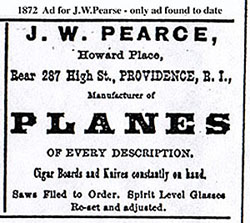J. W. PEARCE
(Jonathan Willard Pearce)
By Richard Slaney
Jan 1, 2002
| |
The Early R.I. Toolmakers & Tradesmen
site would like to thank Suzanne L. Bacheller
of Plainville, MA. for sharing with us her
research on Jonathan W. Pearce. Sue's timeline
gives us a window into the life of an
important early toolmaker. What follows is
based on our own research. Our research builds
on Sue Bacheller's timeline, but the ideas
expressed are our own.
Jonathan W. Pearce was four years old in 1820 when his father died. From 1820 to 1831, Jonathan's affairs were managed by his uncle and legal guardian, Nathaniel Pearce. Acting as guardian, Nathaniel in 1822 paid Nathan Bowen of Rehoboth for providing the young Jonathan with "boarding, clothing, & schooling." In 1831, Lyndall Bowen of Rehoboth replaced Nathaniel Pearce as Jonathan's guardian. Jonathan Pearce in 1831 turned sixteen years old and would have been on his way to learning a trade. We believe that he learned his trade in Rehoboth. His parents, his guardians,his teachers were all Rehoboth people and the Rehoboth neighborhhood he grew up in was but two miles from where Ezekiel Smith had his toolmaking and planemaking shop.
Ezekiel Smith worked as a planemaker in
Rehoboth from 1823 when he took over his
father's workshop until 1849 when he moved to
Smithfield, R.I. In addition to toolmaking,
Ezekiel for ten years owned a 7/16 share in
the Peck sawmill and gristmill in Rehoboth.
Smith's neighbor, Otis Peck, also owned a 7/16
share. Otis Peck's daughter, Grace C. Peck, in
1835 married Jonathan W. Pearce. Jonathan was
twenty when he married in 1835 and had
probably completed an apprenticeship. We
believe that Jonathan apprenticed as a
toolmaker to Ezekiel Smith. After completing
his apprenticeship Pearce may have worked as a
journeyman planemaker for Ezekiel Smith.
Ezekiel had three sons who would become
planemakers, but in 1835 the oldest son was
just ten years old. A June 17, 1844 land deed
shows that Jonathan Pearce was calling himself
a planemaker in 1844 and that he was still
living in Rehoboth. The births of his first
two children and his second marriage all took
place in Rehoboth and it is reasonable to
think that he spent many if not all of the
years between 1835 and 1845 living and working
in Rehoboth. There is a "J.W. PIRCE" plow
plane that is date stamped on the toe " 1840".
This plane is evidence that Pearce was working
on his own before moving to Fall River in
1845. There is no location imprint on his
earliest planes, but we believe that at least
some of the planes stamped "J.W. PIRCE"
"WARRANTED" were made in Rehoboth before 1845. Sue Bachellor's timeline follows the twists and turns of the life of Jonathan W. Pearce. Beyond the timeline, much of what happened in Pearce's life we may never know, much less understand. But one thing is obvious. His life was given strong direction by the trade he learned as a young man in Rehoboth. Jonathan W. Pearce died in 1881. In 1879, at the age of sixty four, he was still working as a planemaker on the west side of Providence. J.W. Pearce Timeline - courtesy of Sue Bachellor. |
